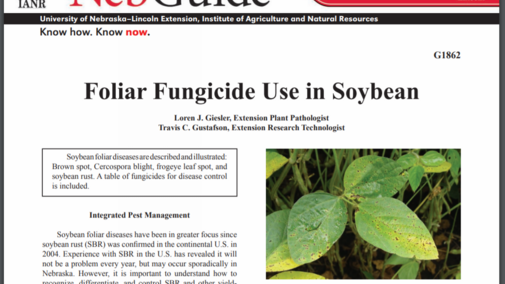New or newly revised publications from Nebraska Extension include:
Foliar Fungicide Use in Soybean (G1862)
This illustrated publication shows examples of foliar soybean diseases such as Brown spot, Cercospora blight, frogeye leaf spot, and soybean rust and offers information on how to control them with fungicides and integrated pest management strategies.
Seed Treatment Fungicides for Soybeans (G1852)
Seedling diseases frequently cause economic yield losses for soybean farmers across the Midwest. These most often manifest as damping off and seed rot, which result in poor emergence, loss of stand, and reduced yield. The most common pathogens that cause seedling diseases are species of Fusarium, Phytophthora, Pythium, and Rhizoctonia. All four are capable of killing soybean seedlings or at least causing damage sufficient to reduce the yield potential of infected plants.
Cover Cropping – A Primer (G2284)
When deciding how best to use cover crops, it is important to consider the ultimate goal. Is it to increase soil organic matter, increase nutrient availability to subsequent crops, reduce soil compaction, supply forage for livestock, and/or suppress weeds? Answering these questions will help identify the cover crops that offer the best chance of success for meeting the goal. Primarily, cover crops are used to enhance soil conservation, nutrient cycling and supply, and weed control. However, these benefits vary based on the species of cover crop that is planted, so it is important to select the crop type that will fit into your current cropping system, as well as provide the desired outcome.
Nebraska On-Farm Research Network: 2016 Growing Season Results (EC3004).
Presents results of 80 agronomic research studies conducted across Nebraska by farmers participating in the Nebraska On-Farm Research Network. A wide range of topics and products are included. This is a valuable resource for anyone looking to make management decisions that will improve farm productivity and profitability.
First Generation European Corn Borer Spreadsheet (EC3018)
Excel® spreadsheet designed to be used in the field on mobile devices to allow the user to make a management decision for first generation European corn borer in non-Bt corn after scouting. The decision to treat for European corn borer is complex and affected by many variables such as weather, plant maturity, borer survival and development, anticipated corn prices, insecticide efficacy, and costs versus anticipated returns.
Simplified Forms of Deep Percolation Estimation (EC3015)
Deep percolation (DP) is an important variable in hydrologic cycle and water balance analyses. It also is important when quantifying crop water use (evapotranspiration), irrigation requirements (IR), recharge analyses, nutrient and micronutrient movement in the soil profile and below the crop root zone, and other analyses.
Simplified Forms of Surface Run-Off Estimation (EC3016)
Surface runoff, the amount of water that runs off a field after precipitation or irrigation, can occur from irrigated, rain-fed, or dryland fields. Because it depends on numerous factors, runoff is a difficult variable to measure and/or quantify. However, when using a soil-water balance approach to estimate crop water use or evapotranspiration (ET) and/or crop irrigation requirements (IR), this variable needs to be taken into account.
Agriculture in the Nebraska Panhandle (EC864)
Agriculture in the Nebraska Panhandle is a diverse composition of livestock and crop production. The University of Nebraska-Lincoln Panhandle District consists of 16 counties in western and north central Nebraska covering 20,000 square miles and representing about 30% of Nebraska's land area. The numbers provide a profile of agriculture in this district.
These and many more Nebraska Extension publications are available at extensionpubs.unl.edu.

